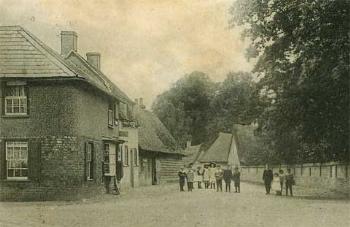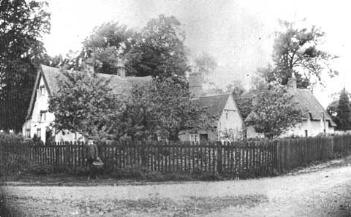The Parish of Roxton in General

Roxton Post Office about 1900 [Z1130/67]
Landscape
Roxton was, before 1 Apr 2007, an extensive parish, before the addition of Wyboston [q.v.] in 1965 (which had previously been in Eaton Socon) it was 2,918 acres. The village of Roxton is in the extreme south-east of the parish. The River Great Ouse forms the western boundary and the low lying ground in the vicinity is liable to flood. The parish is low lying, its highest point being just 279 feet above sea level. The soil is clay and gravel.
Hamlets
Roxton has traditionally included the hamlets of Chawston [q.v.] which lies due north and Colesden [q.v.] which lies north-west. Wyboston, as noted above, was added in 1965 and lies north-east of Roxton, partly along the Great North Road, the modern A1. On 1 Apr 2007, however, these three hamlets became a separate civil parish known as Wyboston, Chawston and Colesden.
Place Name
The name Roxton, first recorded in the Domesday Book, where it appears as Rochestone and Rochesdone means rook hill, from the Old English hroc, meaning rook, and dun, a hill.
Domesday
In the Domesday Book of 1086 the village of Roxton (as opposed to the later parish) is shown as being in the ownership of two men. Hugh de Beauchamp, later created Baron of Bedford, held one hide and one virgate, his tenant being one Rualon, who also held land from him in Chawston and Great Barford. The holding included two smallholders and a slave. It had been worth £1 in 1066 when owned by four freemen of King Edward the Confessor, but by 1086 the value had been halved due to the depredations of William I's army as it travelled north to deal with rebellion.
The major landowner, however, was William Speke who held eight hides and 3 virgates. This manor included 12 villagers, a smallholder and a slave. It included a mill, valued at 33/- and 260 eels and woodland for 20 pigs. In 1066 it had been held by 12 freemen (perhaps the 12 villagers, or their ancestors) and had been worth £10, the value had been cut to a quarter of this when Speke acquired it, but by 1086 it had risen again to £7.

a nineteenth century scene [Z50/97/14]
Manors
The overlordship of this manor, like a number of others, later became vested in the Barony de Trailly and was later attached to the Honour of Gloucester. The first tenants, or underlords, holding Roxton Manor were recorded in 1219 as Henry de Bowels. By 1227 John de Bowels held the manor and was still holding it in 1247. By 1302 the manor was held by Alexander Bosun and it remained in this family until 1447 when Margaret, wife of William Bosun died seized of the manor. Robert Olney, husband of her younger daughter Goditha then inherited the manor.
The manor is not recorded again until 1518 when Robert Throckmorton was recorded as having died seized of it. He was succeeded by his son George who exchanged it for other manors in 1541. In 1553 the crown granted the manor to John, Lord Mordaunt and it remained in that family until 1624 when it was transferred to Gideon de Laune, a French apothecary who was surgeon to James I's queen, Anne of Denmark. Gideon died in 1659 and his son William succeeded. The last time a Delaune is recorded as holding the manor is in 1715. By 1737 Roxton Manor was in the hands of William Metcalfe and it remained in this family until around 1850 when it was sold to Rev.Robert Delap of Monellan [Ireland].
The Manor of Throckmortons or Boxes was created in 1546 by a grant by the crown of a portion of Sir George Throckmorton's property to William Boxe, a citizen and grocer of London. By 1553 it had become the property of John, Lord Mordaunt and its later descent followed that of the Manor of Roxton.
Ardens Manor is first recorded in 1231 when Roger de Hillingdon was summoned to answer Eustacia, wife of Thomas de Ardens for breach of an agreement about six virgates of land in "Ructona", In 1347 Sir Thomas de Ardens, who owned the manor, was outlawed for a felony. The next reference to the manor is in 1543 when a third of it was transferred by Nicholas Bradshawe to Thomas Child, another third being transferred to him by Ralf Heydon inin 1546 whilst in 1548 he acquired the remaininb third. A Robert Child died seized of the manor in 1640 after which no further trace occurs.
The Manor of Carlyles or Roxton Wood End is first recorded in 1472 when it was conveyed by Walter and Joan Stotfold to Richard Carlyle, By 1501 it was in the hands of William Mordaunt after which it follows the same descent as Roxton Manor.
Medieval Murders
Volume XLI of the Bedfordshire Historical Records Society publications is a translation, by R.F.Hunnisett, of medieval coroner’s rolls for the county; entry 34 reads: “On the night of 17 Nov 1269 felons and thieves came to a house in Roxton, in which there were 2 girls, Margaret and Alice daughters of Ralph Bovetoun, broke a wall, entered and robbed and carried away all the goods of the house. They then went to the next house, in which Maud del Forde and Alice Pressande, both of Roxton, were staying, broke its west wall, entered, found Maud in her bed and immediately struck her above the left ear so that her brain issued forth and she immediately died; struck Alice on the top of the head, apparently with a “Denech” axe [a Danish axe, or a battle-axe with a very long blade] so that she lay without speaking and died the same night; and then carried away all the goods of the house. Next they went to the house of John the Cobbler of Roxton, broke its east door and west windows, entered, immediately assaulted John, striking him on the head to the brain, which issued forth, apparently with a “Denech” axe and in the stomach apparently with a “fauchoun”, so that his bowels issued forth; they then took from the house into the street and immediately killed him there. They also wounded John’s wife Alma and his daughter Agnes in their heads, apparently with an axe, in their bodies near their hearts with a knife, and in their hattrels and arms so that their lives were despaired of. Another daughter Alice, who was in the house, ran and hid between a basket and a chest. They also struck John’s servant, Walter of St.Neots, above the left ear so that he fell as if dead. They then robbed and carried away all the goods of the house. Alice, who had hidden in the house, first found John dead……Before she died Azeline [sic] wife of John the Cobbler said before the coroner that she recognised certain of those who were present at the felony, namely Richard de Nevile, who formerly served the prior of Newnham, certain men who that autumn collected the tithes of the prior of Cauldwell in Roxton field, and glovers of Bedford. Afterwards their names were sought by the coroner, and Reynold of Polebrook and Adam, Alan and Simon Corbin were arrested in the liberty of Bedford. Richard was arrested on the indictment of Azeline, who was taken to gaol to view him - and elsewhere said that he was present at the felony, Afterwards he was delivered before Nicholas Peyvere and others, justices of gaol delivery assigned by the king’s writ…” The outcome, sadly, is not recorded.

A nineteenth century lacemaker and visitors [Z50/143/169]
Population
Seventeen men are noted in Roxton in 1086. This figure has to be multiplied by a factor of at least four to account for their dependents, giving an estimated population of around 70. More modern population statistics are as follows:
1801: 465 1851: 622 1901: 349 1951: 607 2001: 1271